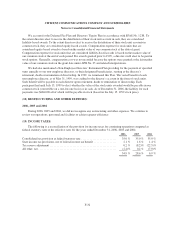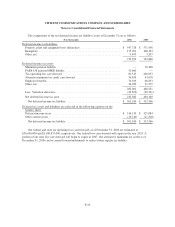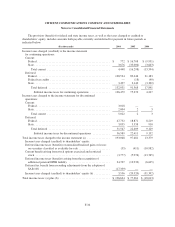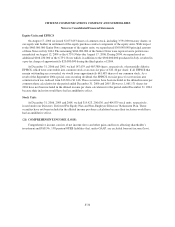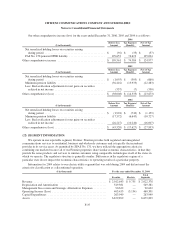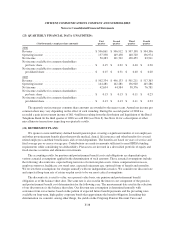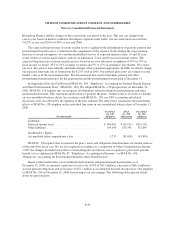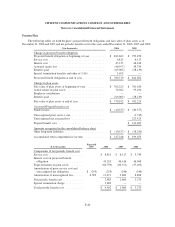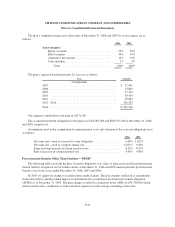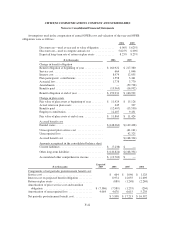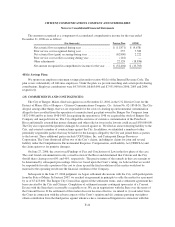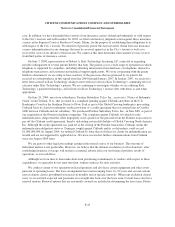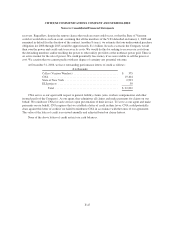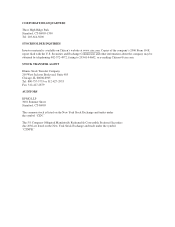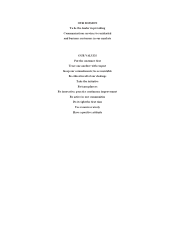Frontier Communications 2006 Annual Report Download - page 87
Download and view the complete annual report
Please find page 87 of the 2006 Frontier Communications annual report below. You can navigate through the pages in the report by either clicking on the pages listed below, or by using the keyword search tool below to find specific information within the annual report.
CITIZENS COMMUNICATIONS COMPANY AND SUBSIDIARIES
Notes to Consolidated Financial Statements
Bloomberg Finance and the changes in those rates from one period to the next. This rate can change from
year-to-year based on market conditions that impact corporate bond yields. Our discount rate increased from
5.625% at year end 2005 to 6.00% at year end 2006.
The expected long-term rate of return on plan assets is applied in the determination of periodic pension and
postretirement benefit cost as a reduction in the computation of the expense. In developing the expected long-
term rate of return assumption, we considered published surveys of expected market returns, 10 and 20 year
actual returns of various major indices, and our own historical 5-year and 10-year investment returns. The
expected long-term rate of return on plan assets is based on an asset allocation assumption of 35% to 55% in
fixed income securities, 35% to 55% in equity securities and 5% to 15% in alternative investments. We review
our asset allocation at least annually and make changes when considered appropriate. In 2006, we did not change
our expected long-term rate of return from the 8.25% used in 2005. Our pension plan assets are valued at actual
market value as of the measurement date. The measurement date used to determine pension and other
postretirement benefit measures for the pension plan and the postretirement benefit plan is December 31.
In September 2006, the FASB issued SFAS No. 158, “Employers’ Accounting for Defined Benefit Pension
and Other Postretirement Plans” (SFAS No. 158). We adopted SFAS No. 158 prospectively on December 31,
2006. SFAS No. 158 requires that we recognize all obligations related to defined benefit pensions and other
postretirement benefits. This statement requires that we quantify the plans’ funded status as an asset or a liability
on our consolidated balance sheets. In accordance with SFAS No. 158, our 2005 accounting and related
disclosures were not affected by the adoption of the new standard. The table below summarizes the incremental
effects of SFAS No. 158 adoption on the individual line items in our consolidated balance sheet at December 31,
2006:
($ in thousands)
Pre SFAS
No. 158
Adoption
SFAS
No. 158
Adjustment
Post SFAS
No. 158
Adoption
Liabilities:
Deferred income taxes ............................... $ 564,041 $ (49,911) $514,130
Other liabilities ..................................... 199,100 133,545 332,645
Stockholder’s Equity:
Accumulated other comprehensive loss .................. 1,735 (83,634) (81,899)
SFAS No. 158 requires that we measure the plan’s assets and obligations that determine our funded status as
of the end of the fiscal year. We are also required to recognize as a component of Other Comprehensive Income
“OCI” the changes in funded status that occurred during the year that are not recognized as part of net periodic
benefit cost as explained in SFAS No. 87, “Employers’ Accounting for Pensions,” or SFAS No. 106,
“Employers’ Accounting for Postretirement Benefits Other Than Pensions.”
Based on the funded status of our defined benefit pension and postretirement benefit plans as of
December 31, 2006, we reported a gain (net of tax) to our AOCI of $41.4 million, a decrease of $66.1 million to
accrued pension obligations and an increase of $24.7 million to accumulated deferred income taxes. Our adoption
of SFAS No. 158 on December 31, 2006, had no impact on our earnings. The following tables present details
about our pension plans.
F-39





